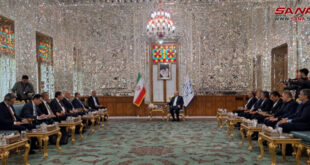Sweida, SANA_ Baal Shamin Temple, which is located in the archaeological site of the eastern countryside of Sweida, is distinguished by the beauty of its geometric and architectural decorations that are carved as plant shapes, especially vine in addition to the figures carved within the Acanthus leaves that decorate the Corinthian crowns of the columns.
Baal Shamin is the largest temple in the southern area of Syria and the most important part of the “gods compound”, which is located on the western end of the western mountainous region. It consists of an altar and a courts and it dates back in time to the years 23 and 1 BC.
Head of Sweida Antiquities Department, Dr. Nasha’at Kiwan said that the Temple of Baal Shamin, or what is called “the God of the Heavens”, is considered the most important monument in the archaeological site of Saiy’a, as its ruins indicate its high position.
The temple consists of the main gate on the eastern side, which dates back to the era of the Roman leader, Severianus, in the second half of the second century AD, of which only the foundations of its right tower are left, in addition to a large courtyard.
A defensive tower is located in its northeastern corner and in its northwestern corner there are the ruins of an administrative building dating back to the second century AD, as well as the chapel located in the middle of the temple courtyard.
Kiwan pointed out that there are ruins for another temple located on the southern end of the Baal Shamin Temple, which was likely built during the reign of the Nabateans king Rabbel II between 70 and 106 AD according to a Roman plan and decorations.
There are also ruins of a square-shaped building that looks like a tower and is located between two courtyards, one of them is wider than the second. As for the central courtyard, which is the front sanctuary of the temple of Baal Shamin god, parts of its wall are still clearly identifiable.
Kiwan clarified that, during the previous years of excavation, the entire Baal Shamin Temple was discovered.
A number of important archaeological finds, including bronze coins, pottery, a saddle, parts of Nabateans and Greek writings, and some of the inscriptions and architectural decorations that used to decorate the Temple of Baal Shamin, were also found in addition to writing that indicates the history of the temple’s building in the Nabateans and Greek languages, dating back to the first century BC, some of them carry the name of Ous Ibn Malika, who wrote the inscription of the temple’s construction.
The site of Saiya is one of the important archaeological areas in Sweida governorate and southern Syria where the Arab tribes and residents of the region visited it frequently as the ancient artists immortalized it in wonderful paintings decorating the entrances of their temples and their homes’ balconies.
Gh.A.Hassoun
 Syrian Arab News Agency S A N A
Syrian Arab News Agency S A N A


